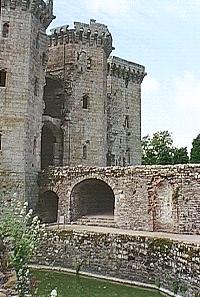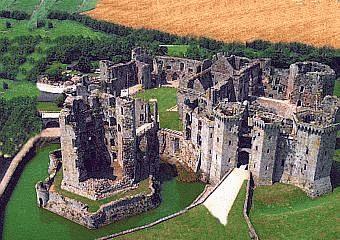Raglan Castle

Raglan Castle is most closely associated with William ap Thomas, who fought with King Henry V at the Battle of Agincourt in 1415.In 1426, ap Thomas was knighted by Henry VI,
becoming known to his compatriots as "the blue knight of Gwent." Sir William Herbert, Earl of Pembroke, was the next owner of the castle, and it is Herbert who is responsible for Raglan's distinctive Tudor-styling. The castle was also the boyhood home of Henry Tudor, later King Henry VII. As a boy he bided his time at Raglan, while his uncle Jasper agitated a Lancastrian return to the throne in the person of young Henry.
Both William ap Thomas and William Herbert fought in France, and undoubtedly, the castles that they saw in that country influenced their work at Raglan. The elaborately decorated polygonal keep, as well as the double-drawbridge arrangement of the keep, unique in Britain, demonstrate French influence. In 1492, Elizabeth Herbert married Sir Charles Somerset, a natural son of Henry Beaufort, third duke of Somerset, and it is to the Somerset family as earls of Worcester that we owe the final architectural touches of the castle.
On approaching the gatehouse, you pass Raglan's Great Tower, surrounded by its apron wall and beautiful moat. The wall has six corner turrets, one of which has a postern door to the moat. The Great Tower, known as "The Yellow Tower of Gwent," is the most striking feature at Raglan. It was begun by Sir William ap Thomas and was designed very much in contemporary French style. Unfortunately, the tower was largely destroyed by Parliamentary forces during the English Civil War. The tower and moat are outside the main body of the castle. The Great Gate leading to the Pitched Stone Court lies next to The Great Tower. It was raised by Sir William Herbert, and served as the main entrance to the castle after 1460, however, we chose to continue surveying The Great Tower from the outside, via the park surrounding the moat, finally entering the castle from the South Gate.
Through the South Gate, you enter the main Apartments. The two most impressive rooms at Raglan are The Hall and Long Gallery. The hall is the finest and most complete of the castle's surviving apartments. A plaque over the dais in the hall bears the distinctive arms of the third earl of Worcester, as Knight of the Garter. The Long Gallery has been called one of the finest rooms of Tudor rebuilding in Britain. Once a showcase of Tudor elegance, the gallery contained handsome paintings, tapestries and sculptures. During this time, Raglan was one of Britain's social centres. Important guests were entertained until the early hours of the morning. The gallery had a series of windows overlooking the Fountain Court, and an ornate Renaissance fireplace. The remains of the fireplace, clearly showing two carved human figures, are a major highlight of the castle.
Re-entering the castle through the Great Gate, you enter the Pitched Stone Court, a large cobblestone area. Standing at the end of the court gives a magnificent view of the rear of the gatehouse and the Attic. The Attic, with its stunning Tudor-style windows, housed another gallery running along the rear of the gatehouse range. The building once held the castle's extensive library, which was also destroyed by Cromwell's soldiers.
 Raglan, stately and handsome, is perhaps deceptive. The might of its angular towers bears comparison with the great castles of Edward I, and suggests its origins lay in the bitter conflicts of the later 13th century. In face it belongs mainly to the 15th century, and was as much a product of social aspiration as it was of military necessity.
Raglan, stately and handsome, is perhaps deceptive. The might of its angular towers bears comparison with the great castles of Edward I, and suggests its origins lay in the bitter conflicts of the later 13th century. In face it belongs mainly to the 15th century, and was as much a product of social aspiration as it was of military necessity.
It was begun by Sir William ap Thomas, a veteran of the French wars, who grew wealthy through exploiting his position as a local agent of the duke of York in south-east Wales. About 1435 he began building the Great Tower, subsequently known as the Yellow Tower of Gwent, probably on the site of a much earlier Norman motte and bailey castle. Surrounded by a water-filled moat, the unusual hexagonal plan of the tower, together with its elaborate drawbridge arrangements, are more easily paralleled in France than in Britain. Within, there was a single large room to each floor, and the entire structure echoed the power and influence of its builder.
Following ap Thomas's death he was succeeded by his son William Herbert who continued to develop Raglan. As a prominent Yorkist, he played a major role in securing the throne for Edward IV in 1461, and was raised to the peerage as Lord Herbert of Raglan. Eventually rising to earl of Pembroke, his political career is reflected in his sumptuous building. Under Herbert, Raglan became a veritable palace, unmatched in the 15th century southern March. He added the great gatehouse, the Pitched Stone Court and also rebuilt the Fountain Court with a series of formal state apartments for himself and his household. All of these repay careful examination. Notice, for example, the circular gun ports in the lower part of the gatehouse. The great kitchen lay in the tower at the corner of the Pitched Stone Court, and its huge ovens and fireplaces remain.
Herbert was beheaded following his defeat at the battle of Edgecote in 1469, and there were no further major alterations to Raglan until the ownership of William Somerset, earl of Worcester (1548-89). In the main, he was responsible for extensive changes to the hall, which remains the finest and most complete of all apartments in the castle. The huge fireplace survives, as does the tracery of the beautiful windows. These were once filled with heraldic glass, and the roof was built of Irish oak. Earl William also added the long gallery, without which no great Elizabethan house was complete.
At the outbreak of the Civil War, Raglan was garrisoned for the king. Henry, the new earl, and later marquess of Worcester,poured his fortune into the royal cause. By 1646 the castle
was under siege, one of the longest of the Civil War. It was pounded by heavy artillery under the command of Sir Thomas Fairfax, and finally the elderly marquess was forced to surrender.
The fall of Raglan virtually marked the end of the Civil War, and Cromwell's demolition engineers were soon at work reducing the great walls. However, the strength of the Great Tower was almost great enough to defy them. Only after 'tedious battering the top thereof with pickaxes', did they eventually undermine the walls and two of its six sides were brought crashing down in a mass of falling masonry.